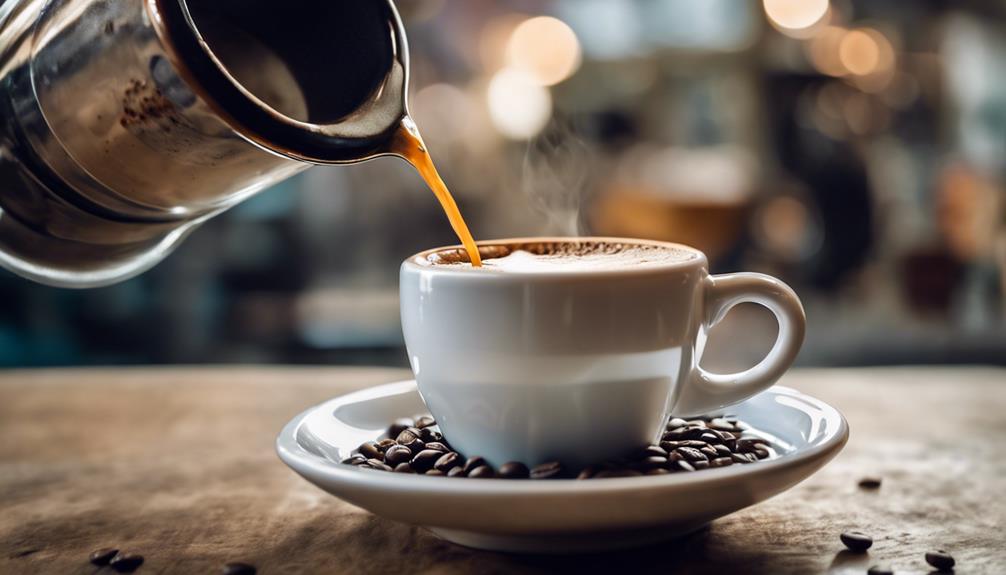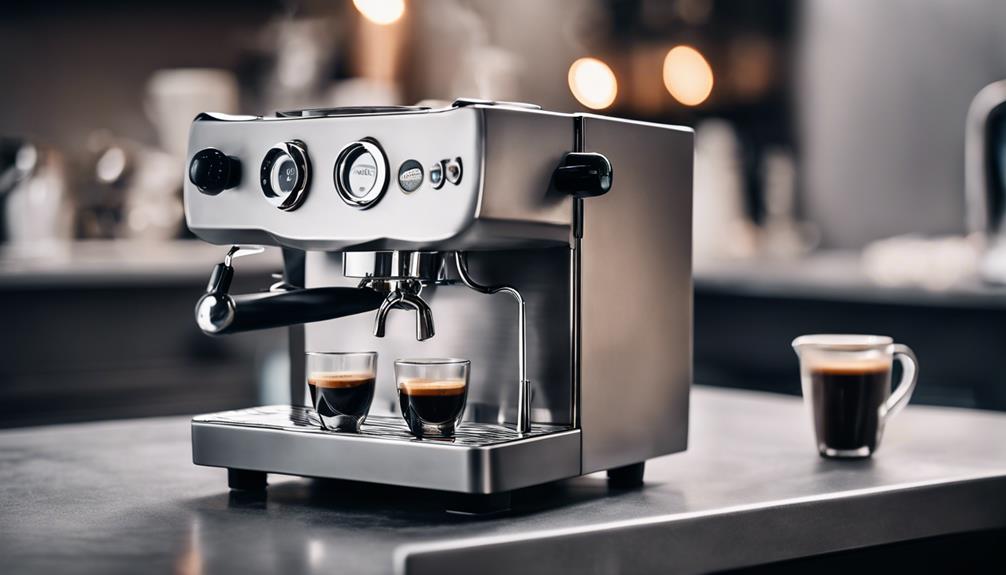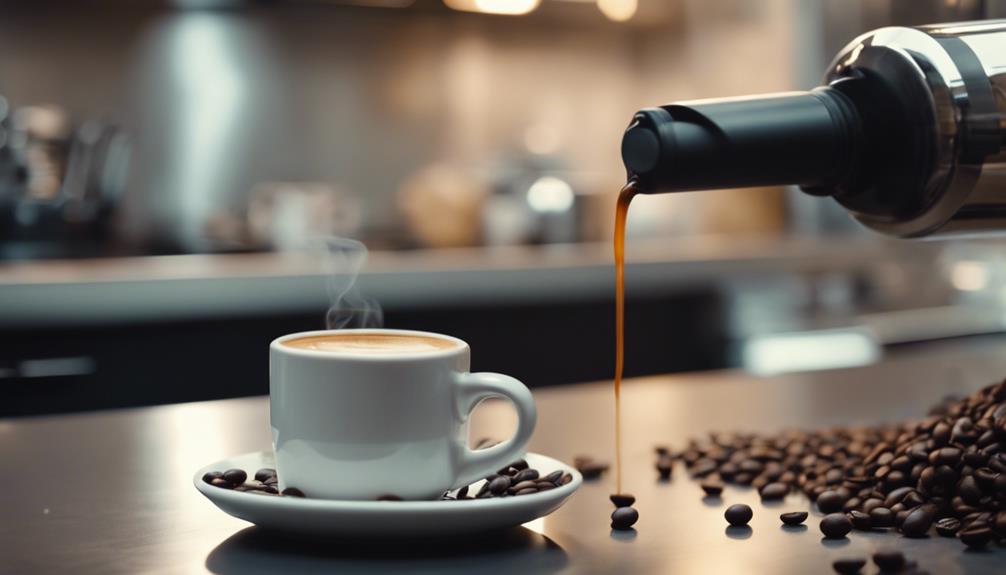Discover the unique concept of upside-down espresso, with milk as the base layer, followed by espresso shots and foam. This fresh twist provides a delightful mix of flavors, enhancing sweetness and creaminess. Baristas must demonstrate precision and expertise to master the reversed layering process. The various customization options allow for a tailored experience, resulting in visually appealing drinks. This sensory journey deviates from the traditional serving style, introducing new taste combinations and textures. Starbucks’ unconventional method brings a sense of excitement and diversity to your regular order. Immerse yourself in the realm of upside-down espresso for a unique and innovative flavor encounter.
Key Takeaways
- Upside-down espresso reverses traditional layering, enhancing flavor balance.
- Distinct tactile experience with milk leading before espresso.
- Baristas face challenges in mastering the unconventional preparation process.
- Offers a unique sensory adventure with altered flavor and texture interactions.
- Customization options allow for personalization and visual appeal.
Starbucks Upside-Down Espresso Process
To prepare Starbucks' Upside-Down Espresso, baristas pour the milk first, followed by the espresso shots and foam in a reverse layering process. This method is a unique twist on traditional espresso drinks like the Espresso Macchiato or the upside-down Caramel Macchiato.
By starting with the milk, the espresso shots are then poured over it, with the foam on top, creating the perfect balance of flavors in each sip. This unconventional approach to layering ingredients results in a distinct taste experience for espresso enthusiasts.
While this process may pose a challenge for some baristas due to its unconventional nature, the end result is often worth the effort. Some Starbucks locations may charge extra for the customized preparation of an upside-down espresso, reflecting the additional time and attention required to craft this specialty drink.
If you enjoy this creative take on espresso, consider tipping your barista as a gesture of appreciation for their skill and effort in preparing your order.
Flavor Impact of Milk First
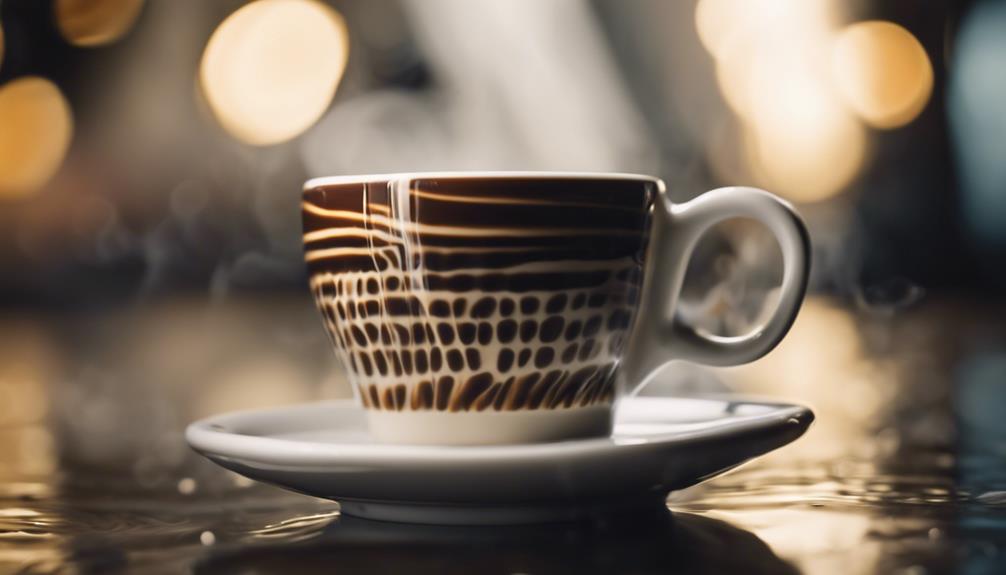
Starting with the milk when making an upside-down espresso can noticeably alter the flavor profile of the drink. By pouring the milk first, you're setting the stage for a unique experience where the creamy texture takes the lead before the shot of espresso.
This change of the classic Macchiato order can result in a drink with a different balance of flavors. The shift from Milk to Espresso can impact the intensity and overall taste of your upside-down Macchiato. This adjustment can enhance the sweetness and creaminess of the milk, offering a pleasant surprise to your taste buds.
The flavor profiles in an upside-down espresso are distinct, with the milk playing a more prominent role in each sip. This alteration in layering not only affects the taste but also contributes to the overall richness and smoothness of the drink.
Experimenting with this unconventional method can open up a whole new world of coffee experiences for you to enjoy.
Textural Differences in Upside-Down Espresso
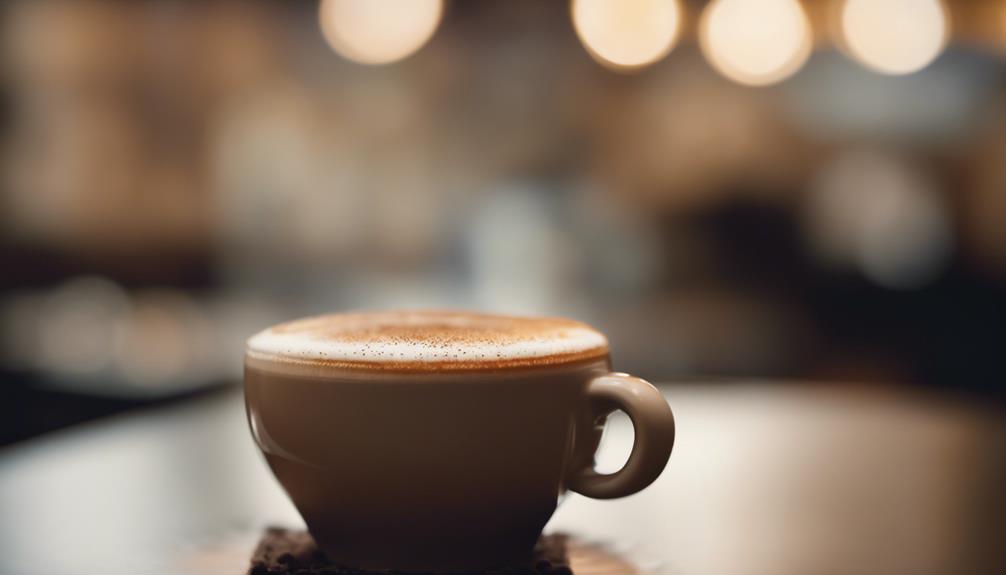
When you order an Espresso upside-down, you're in for a richer mouthfeel experience. This unique preparation enhances flavor extraction, giving you a more integrated and harmonious drink.
The textural differences in Upside-Down Espresso can truly elevate your coffee experience.
Richer Mouthfeel Experience
Experience a velvety richness in each sip of upside-down espresso, as the milk at the bottom creates a creamier texture that enhances your overall drinking pleasure.
The unique textural differences in upside-down espresso result in a richer mouthfeel, offering a more integrated taste profile that sets it apart from traditional espresso drinks.
By having the milk layered beneath the espresso, every sip provides a distinct tactile sensation that blends the flavors in a way that's both satisfying and smooth.
This innovative approach to serving espresso not only creates a creamier consistency but also guarantees a balanced and harmonious combination of milk and coffee flavors.
The reverse layering technique in upside-down espresso allows for a more nuanced drinking experience, where the creaminess of the milk complements the boldness of the espresso, resulting in a beverage that's both indulgent and refined.
Enjoy the enhanced mouthfeel and integrated taste of upside-down espresso for a truly unique coffee experience.
Enhanced Flavor Extraction
To explore the enhanced flavor extraction in upside-down espresso, consider how the inverted layers influence the textural differences of the brew.
When the espresso shot is poured last in an upside-down order, the coffee oils from the grounds have a longer contact time with the milk. This prolonged exposure allows for enhanced flavor extraction, resulting in a bolder and more robust taste experience.
The inverted layers in upside-down espresso contribute to a smoother mouthfeel and a more integrated blend of flavors compared to traditional preparation methods. The heightened interaction between the coffee oils and the milk leads to a more nuanced flavor profile, highlighting subtle nuances in the coffee and creating a more dynamic drinking experience.
Challenges for Baristas
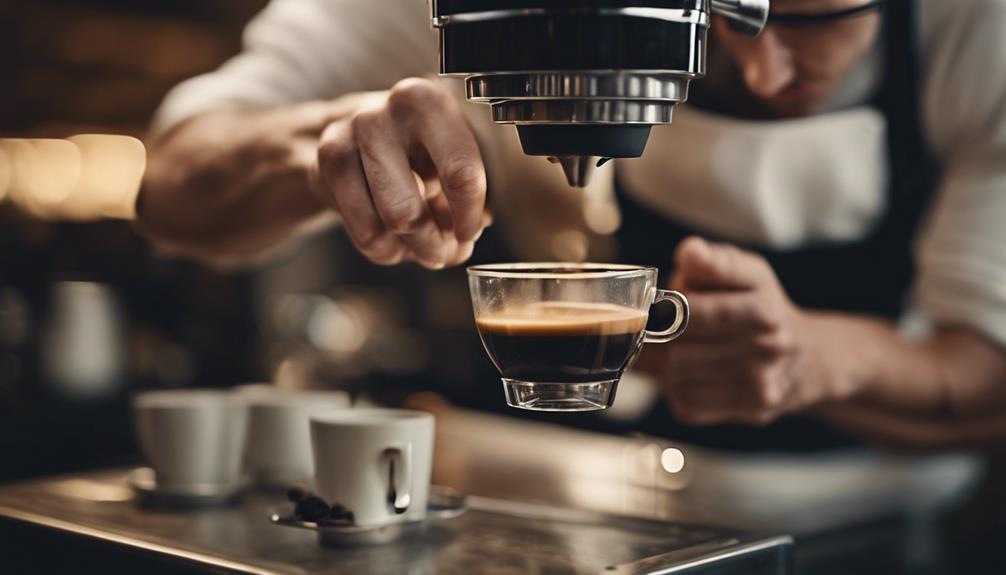
Challenges can arise for baristas when preparing upside-down drinks due to the need to reverse the layering process. In espresso drinks, where the order of ingredients is vital, flipping this arrangement can disrupt the usual flow of preparation. This reversal demands a higher level of precision and attention to detail from baristas.
The intricate nature of upside-down drinks adds complexity to their routine, requiring them to carefully navigate through the layering process to make sure the final outcome meets expectations. Some Starbucks locations even charge extra for these modified drinks, further complicating matters for baristas.
Despite these challenges, skilled baristas can efficiently adapt to the demands of upside-down espresso drinks to cater to customer preferences. It's a test of their expertise and ability to handle the intricacies of this unique preparation method while maintaining the quality and standards expected in the coffee industry.
Novelty and Fun Twist
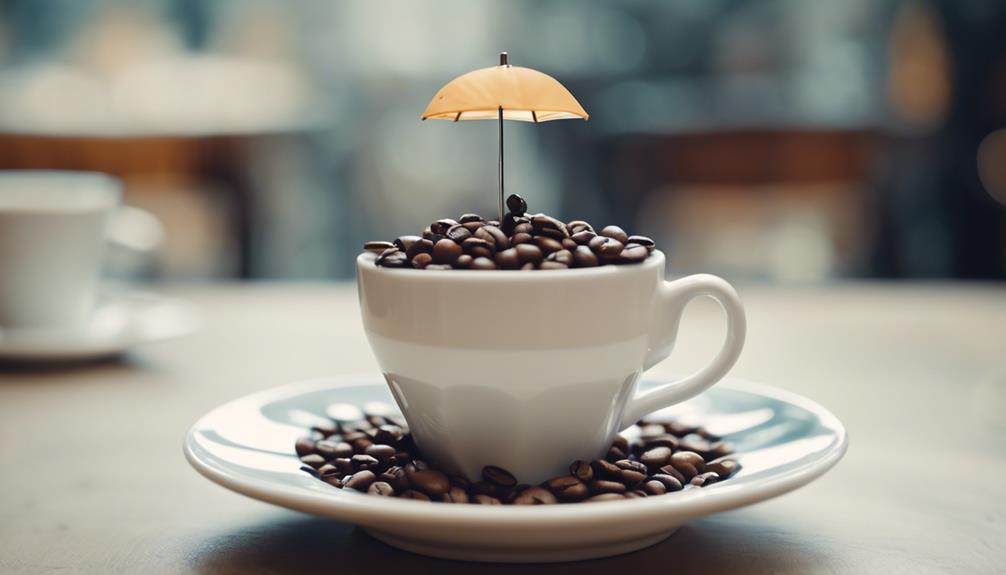
Ordering an upside-down espresso can bring a fun twist to your coffee routine, offering a unique presentation and flavor experience.
The reversal of layering in this drink surprises your taste buds with a different profile, creating an exciting variation in your usual order.
Baristas may enjoy the challenge of preparing this unconventional espresso, adding a touch of creativity to your coffee experience.
Upside-Down Espresso Presentation
Adding an unexpected twist to your espresso experience, the upside-down presentation offers a playful and novel approach to enjoying your coffee. When you order an espresso upside-down, you can expect a visually striking and unique beverage.
By inverting the layers in an espresso drink, this unconventional preparation creates a novel and exciting drinking experience. Starbucks, known for its innovative offerings, serves upside-down espresso as a conversation starter due to its unconventional preparation method.
The novelty of upside-down espresso can make it a memorable and enjoyable choice for coffee enthusiasts seeking something different. The upside-down presentation not only adds a fun twist to the traditional espresso experience but also opens up a world of creativity and enjoyment for those looking to try something new in their coffee routine.
Give it a try next time you visit your favorite coffee spot and experience the delight of savoring your espresso in a whole new way.
Enjoyment of Unique Flavor
Indulge in the delightful novelty of an upside-down espresso, where the unique flavor profile promises a fun twist on your coffee experience. When you opt for an upside-down espresso, the layering of ingredients is inverted, providing a distinct taste experience that deviates from the conventional approach. This alteration in how the espresso is poured creates a blend that surprises your taste buds and adds excitement to your coffee routine.
To better understand the enjoyment of unique flavor in an upside-down espresso, consider the following aspects:
| Aspect | Description |
|---|---|
| Distinct Taste | The unconventional layering of ingredients leads to a unique flavor profile that stands out. |
| Novelty Factor | Trying an upside-down espresso offers a break from the norm, enhancing the overall coffee experience. |
| Fun Twist | The distinct taste experience of an upside-down espresso can add a touch of excitement to your day. |
Embrace the unconventional and savor the distinctive flavor journey an upside-down espresso has to offer.
Customization Options
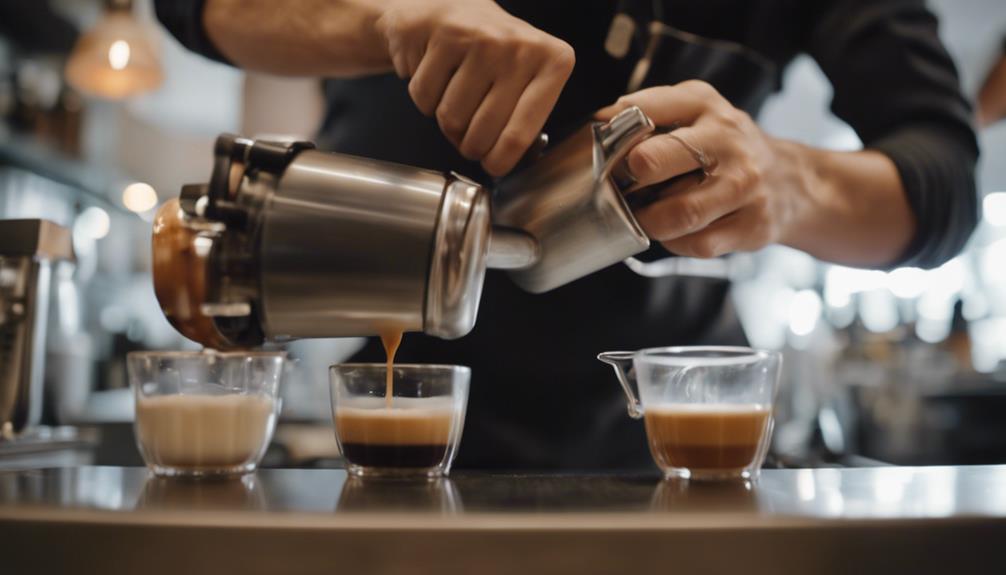
Consider exploring the various ways you can personalize your upside-down espresso to suit your taste preferences. With this unique coffee creation, customization options abound. By altering the layering of milk and coffee, you can create a drink that caters specifically to your liking.
One key aspect of customization is adjusting the amount of foam or milk present in your upside-down espresso. These changes not only affect the visual appeal of your drink but can also impact its overall flavor profile considerably. Baristas, well-versed in the art of coffee customization, can provide suggestions on how to tweak your upside-down espresso to perfection.
Whether you prefer a creamier texture, a stronger coffee taste, or a delicate balance of both, experimenting with different customization options can enhance your upside-down espresso experience. Don't hesitate to ask your barista for recommendations or get creative with your own customization ideas to make your upside-down espresso truly one-of-a-kind.
Sensory Experience Variation
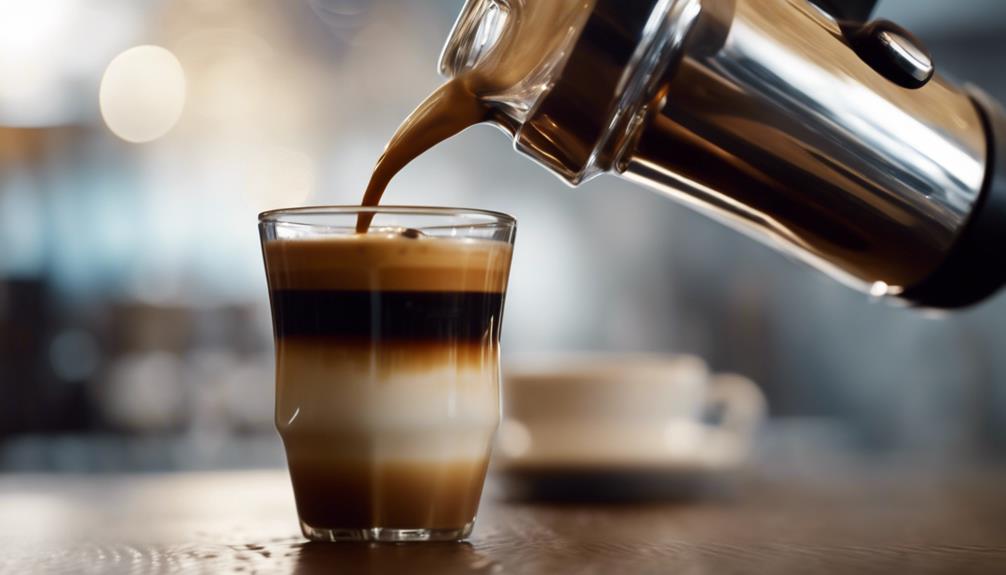
Enhancing your espresso experience, the sensory profile of an upside-down espresso varies markedly from a traditional serving. When the layers of an espresso are inverted, the usual progression of flavors is disrupted, leading to a novel taste experience. The distinct layering of ingredients in an upside-down espresso alters how the flavors interact, creating a unique and surprising blend on your palate.
Additionally, the texture and mouthfeel of this unconventional serving style can be quite different, offering a new tactile sensation with each sip.
Baristas play an essential role in this sensory exploration by customizing the strength and intensity of flavors through the layering process. By adjusting the sequence in which the ingredients are added, baristas can tailor the taste profile to suit individual preferences.
This customization adds a layer of creativity and personalization to your espresso experience, ensuring that each upside-down espresso surprises and delights with its innovative approach to flavor composition.
Unconventional Preparation Approach

The unconventional preparation approach for an upside-down espresso at Starbucks involves pouring the milk first, creating a unique layering order. This reversal of the typical espresso-making process can lead to a distinct taste experience for customers.
By starting with the milk at the bottom, followed by the espresso and foam on top, the flavors may blend differently, offering a new sensory adventure. However, this method can pose challenges for baristas accustomed to the traditional layering process. Adjusting to pouring the ingredients in reverse order requires skill and precision to achieve the desired outcome.
Customers seeking this unique preparation may encounter variations in pricing at different Starbucks locations, with some establishments charging extra for upside-down espresso drinks. Despite the potential complexity of crafting these beverages, tipping your barista for their efforts is a thoughtful gesture appreciated by many.
This unconventionally layered espresso creation showcases Starbucks' flexibility in catering to diverse preferences and tastes.
Frequently Asked Questions
What Does It Mean When a Drink Is Upside Down?
When a drink is upside down, it means the usual layering order of ingredients is reversed.
In an upside-down espresso, the milk goes first, followed by the espresso and foam. This change affects both the taste and appearance of the drink.
Baristas find preparing upside-down drinks tricky due to the altered layering.
Tipping your barista for an upside-down order is a thoughtful gesture, especially if it requires extra effort.
What Is Americano Upside Down?
When you order an Americano upside down, you're asking for espresso to be poured over hot water instead of the usual way. This method mixes the flavors more evenly, creating a smoother taste.
It alters the usual layering of ingredients, giving you a different experience. Upside-down Americanos are loved by many for their integrated and unique flavor profile, offering a nuanced twist on the traditional preparation.
What's the Difference Between a Latte and a Macchiato?
A latte consists of espresso, steamed milk, and foam, blending the layers, while a macchiato has espresso with a touch of foam in distinct layers.
Latte Macchiato has more steamed milk than espresso, creating a creamier taste, unlike a traditional macchiato.
Caramel Macchiato includes caramel syrup for sweetness, adding a unique flavor.
Cloud Macchiato offers a foam layer for a different texture twist.
Each variant caters to diverse preferences in taste and texture.
What Is the Difference Between a Ristretto and a Long Shot at Starbucks?
At Starbucks, the difference between a ristretto and a long shot lies in their preparation.
A ristretto shot is a smaller, more concentrated espresso with a sweeter, richer flavor due to the reduced water volume.
On the other hand, a long shot uses more water, resulting in a milder taste.
Ristretto shots pack a caffeine punch in a smaller size, offering a potent kick, while long shots provide a gentler coffee experience.
How Does Lower Acid Espresso Compare to Upside-Down Espresso in Taste and Flavor?
Are you curious about the differences between lower acid espresso and upside-down espresso in taste and flavor? This decoding lower acid espresso article will help you understand the unique characteristics of each type. Whether you prefer a milder flavor or a bolder, more acidic taste, this article will provide valuable insights for your coffee preferences.
How Can Upside-Down Espresso be Differentiated from Regular Espresso?
When differentiating upside-down espresso from regular espresso, it’s important to consider the brewing method. Upside-down espresso involves flipping the coffee maker, while regular espresso is brewed in the traditional upright position. Additionally, always prioritize espresso grounds disposal safety to avoid any potential hazards.
What Makes Upside-Down Espresso Shots Unique?
The unique upside down espresso shot is a creative twist on traditional espresso preparation. By flipping the brewing process upside down, the flavors are intensified and the texture becomes richer. This innovative method allows for a truly unique and bold coffee experience that is unlike any other.
Conclusion
To sum up, upside-down espresso at Starbucks offers a unique and unconventional twist to the traditional espresso experience. The process of frothing milk first creates a distinct flavor profile, while the textural differences add depth to the drink.
Baristas face challenges in mastering this technique, but the novelty and customization options make it a fun choice for coffee lovers. So next time you're at Starbucks, why not try this anachronistic, but delightful, espresso variation?
